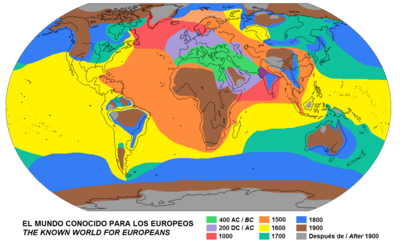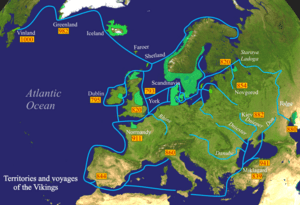Geographical exploration facts for kids
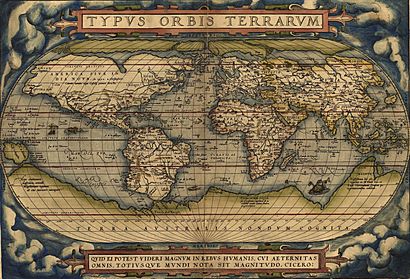
Geographical exploration, sometimes considered the default meaning for the more general term exploration, refers to the practice of discovering remote lands and regions of the planet Earth. It is studied by geographers and historians.
Early writings about exploration date back to the 4th millennium B.C. in ancient Egypt. One of the earliest and most impactful thinkers of exploration was Ptolemy in the 2nd century AD. Between the 5th century and 15th century AD, most exploration was done by Chinese and Arab explorers. This was followed by the Age of Discovery after European scholars rediscovered the works of early Latin and Greek geographers. While the Age of Discovery was partly driven by European land routes becoming unsafe, and a desire for conquest, the 17th century saw exploration driven by nobler motives, including scientific discovery and the expansion of knowledge about the world. This broader knowledge of the world's geography meant that people were able to make world maps, depicting all land known.
The first modern atlas was the Theatrum Orbis Terrarum, published by Abraham Ortelius, which included a world map that depicted all of Earth's continents.
Contents
- Concept
- Two big eras of exploration
- Early explorers and thinkers
- Notable historical periods of human exploration
- Phoenician Galley Sailings (around 1550 BCE – 300 BCE)
- Carthaginian Exploration of Western Africa
- Greek and Roman Exploration (starting around 4th century BC)
- Roman Explorations (around 30 BC – 640 AD)
- Chinese Exploration of Central Asia (starting 2nd century BC)
- Viking Age (around 800 AD to 1040 AD)
- Polynesian Age (starting around 3000 BC, major explorations up to 1280 AD)
- Chinese Exploration of the Indian Ocean (starting 14th century AD)
- European Age of Discovery (early 15th century to 17th century)
- Late Modern Period Exploration (after the 17th century)
- Space Age Exploration (starting 20th century)
- Underwater Exploration
- See also
Concept
Think of exploration as a journey of discovery. It means:
- Looking into something carefully and completely.
- Traveling to new places to find out what's there.
- Checking something out to understand it better.
- Experiencing something new for the first time.
- Sometimes, just wandering to see what you find!
Exploration has been a big part of human history, helping us learn about the world we live in.
Two big eras of exploration
Human history has seen two main periods of exploration:
- The Era of Convergence: This was the very beginning, covering most of the time Homo sapiens (that's us!) have been around. Humans started in Africa and slowly moved out, settling in new places like Europe and Asia. About 14,000 years ago, during the Ice Age, some people even crossed a land bridge from Siberia to Alaska and traveled down into the Americas. During this time, different groups of people developed their own unique ways of life, often without knowing about other groups far away.
- The Era of Divergence: This period started about 10,000 years ago and continues today. It's when people started connecting more through trade and travel. Cultures began to mix and learn from each other, leading to a more connected world.
Early explorers and thinkers
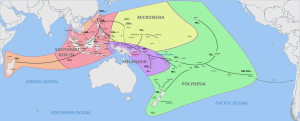
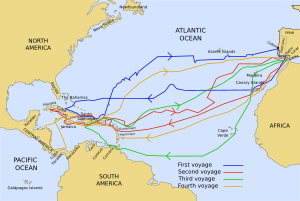
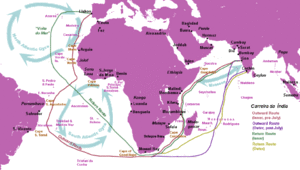
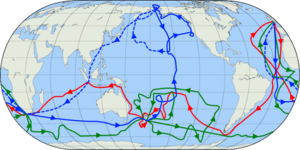
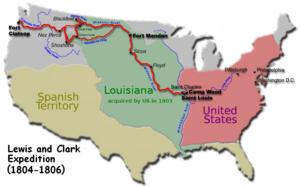
People have been exploring and writing about it for a very long time. Some of the earliest writings about exploration come from ancient Egypt, dating back over 5,000 years.
One really important thinker about geography and exploration was Ptolemy, who lived around 1,800 years ago. His ideas and maps influenced explorers for centuries.
Between the years 400 AD and 1500 AD, explorers from China and the Arab world did a lot of exploring. Later, Europeans rediscovered the works of ancient geographers like Ptolemy, which helped kick off a new period called the Age of Discovery.
While the Age of Discovery was partly driven by wanting new trade routes and sometimes by a desire for conquest, later exploration in the 1600s was more focused on scientific discovery and simply learning more about the world. This growing knowledge allowed people to create world maps showing all the known lands. The first modern collection of maps, called an atlas, was published by Abraham Ortelius and included a map showing all the Earth's continents known at the time.
Notable historical periods of human exploration
Let's take a look at some exciting times in the history of exploration!
Phoenician Galley Sailings (around 1550 BCE – 300 BCE)
The Phoenicians were amazing sailors and traders who traveled all around the Mediterranean Sea and parts of Asia. We don't know all their routes, but finding Phoenician objects made of tin suggests they might have even sailed as far as Britain. Stories say that the legendary Queen Dido, who founded the city of Carthage in North Africa, was a Phoenician sailor.
Carthaginian Exploration of Western Africa
Hanno the Navigator, a Carthaginian explorer around 500 BC, sailed down the western coast of Africa, exploring new areas.
Greek and Roman Exploration (starting around 4th century BC)
The ancient Greeks and Romans also explored many areas.
Pytheas, a Greek explorer from about 2,400 years ago, was one of the first to sail all the way around Great Britain. He also explored parts of Germany and reached a place called Thule, which many people think was the Shetland Islands or Iceland. The Romans explored as far north as the Baltic Sea.
Roman Explorations (around 30 BC – 640 AD)
The Romans were great builders and travelers. They organized expeditions across the vast Sahara Desert in Africa using camels, mainly to find and trade for gold. They explored along the western and eastern coasts of Africa by ship, connecting with trade routes in the Indian Ocean.
The Romans also explored into Northern Europe and even had contact with China in Asia.
Around 100–166 AD, the Romans started trading with China. Roman ships reached places like Thailand, Cambodia, Sumatra, and Java.
In 161 AD, an embassy (like official visitors) from the Roman Emperor reached the Chinese Emperor in a city called Luoyang. In 226 AD, a Roman visitor traveled to northern Vietnam and visited the court of a Chinese ruler in Nanjing.
Chinese Exploration of Central Asia (starting 2nd century BC)
During the Han dynasty in China, explorers ventured far to the west.
Around 139 BC, a Chinese diplomat named Zhang Qian traveled west. He didn't achieve his main goal of finding an ally, but his journeys were incredibly important because he discovered many countries the Chinese didn't know about. He visited places in Central Asia and learned about others further west, like parts of India and the Parthian Empire. He described some of these places as having farms and cities, similar to China.
Viking Age (around 800 AD to 1040 AD)
The Vikings were skilled sailors from Scandinavia who explored vast areas of the North Atlantic and parts of Europe using their longships.
Erik the Red, a Norwegian Viking, sailed to and settled in Greenland around 980 AD after being sent away from Iceland.
His son, Leif Erikson], an Icelandic explorer, is believed to be the first European to reach North America, landing in Newfoundland and nearby areas around 1000 AD.
Polynesian Age (starting around 3000 BC, major explorations up to 1280 AD)
The Polynesians were incredible seafarers who explored and settled islands across the central and southern Pacific Ocean over thousands of years.
A key invention for them was the outrigger canoe, which was fast and stable, perfect for long ocean voyages carrying people and supplies.
Around 1280 AD, Polynesians discovered and settled New Zealand. Studies suggest that a large group of people, including women, arrived around the same time, likely from islands like the Society Islands. They probably used the wind patterns to help them sail. There are similarities in culture and language between people from the Cook Island and the Māori people of New Zealand, suggesting a connection.
Chinese Exploration of the Indian Ocean (starting 14th century AD)
Chinese explorers also made significant voyages across the Indian Ocean.
Wang Dayuan, who lived in the 1300s, made two big sea trips. He sailed through Southeast Asia, reaching Sri Lanka and India, and even visited Australia! Later, he explored parts of North and East Africa.
Even more famous is the Chinese admiral Zheng He, who led seven huge voyages between 1405 and 1433. His fleets visited places like Arabia, East Africa, India, Indonesia, and Thailand, showing the power and reach of Chinese exploration.
European Age of Discovery (early 15th century to 17th century)
This is one of the most famous periods of exploration, sometimes called the Age of Exploration. European explorers sailed across the globe, discovering and mapping vast areas of the Americas, Africa, Asia, and Oceania. Portugal and Spain led the way at first, followed by countries like England, France, and the Netherlands.
Here are just a few of the many important explorers from this time:
- In Africa: Diogo Cão explored the Congo River, and Bartolomeu Dias was the first European to sail around the southern tip of Africa, the Cape of Good Hope.
- Routes to Asia and the Pacific: Vasco da Gama found the first sea route from Europe to India by sailing around Africa. Pedro Álvares Cabral followed this route and also landed in Brazil, connecting Europe, Africa, America, and Asia on one expedition. Explorers like Ferdinand Magellan led the first expedition to sail almost all the way around the Earth (completed by Juan Sebastián Elcano after Magellan's death). They crossed the Pacific Ocean and found a strait at the tip of South America (now called the Strait of Magellan).
- Discovery of America: Christopher Columbus led the first Spanish expedition across the Atlantic, reaching the Americas in 1492. After him, many others explored the new lands. Vasco Núñez de Balboa was the first European to see the Pacific Ocean from the Americas (after crossing Panama), proving that America was a separate continent from Asia. Juan Ponce de León explored Florida, Francisco Vázquez de Coronado explored the Grand Canyon, and Francisco de Orellana was the first European to travel the entire length of the Amazon River. Jacques Cartier mapped parts of Canada.
Late Modern Period Exploration (after the 17th century)
Even after the Age of Discovery, there was still much to explore. Russian explorers reached the Pacific coast of Siberia and the Bering Strait, which separates Asia and North America. #Vitus Bering explored this strait and the coast of Alaska.
- James Cook explored the east coast of Australia, the Hawaiian Islands, and sailed around Antarctica.
- In North America, the Lewis and Clark Expedition (1804–1806) explored the vast lands of the Louisiana Purchase, looking for a water route to the Pacific and studying the plants and animals.
Exploration also went into the deep sea.
- In 1818, John Ross discovered that there was life in the deep ocean.
- The United States Exploring Expedition (1838–1842) explored the Pacific Ocean and surrounding lands.
In the 20th century, technology like sonar and deep-diving submersibles allowed us to explore the deep ocean much better.
- In 1960, Jacques Piccard and Donald Walsh went down to the deepest part of the ocean, the Mariana Trench.
- More recently, in 2018, Victor Vescovo reached the deepest point of the Atlantic Ocean.
While we've mapped most of the Earth's surface from above using satellites and planes, there are still remote places and hidden parts of the world to explore, like undocumented tribes or hard-to-reach ecosystems. Urban exploration is even a type of exploration where people explore abandoned buildings or hidden parts of cities.
Space Age Exploration (starting 20th century)
With the invention of rockets that can leave Earth's atmosphere, exploration went beyond our planet! Humans have traveled to the Moon. Robotic explorers have been sent to other planets and even out of our solar system, like the Voyager probes, which carry messages from Earth.
Underwater Exploration
Exploring underwater is a huge and ongoing effort! It aims to find out about the amazing variety of life in the ocean, measure things like water temperature and currents, and map the shape and features of the ocean floor.
The ocean covers about 70% of our planet and is super important for life, but we still know very little about it because it's hard and expensive to explore. As of January 2023, more than 80% of the ocean is still unmapped, unobserved, and unexplored. Less than 10% of the ocean has been mapped in detail using sonar technology. Most maps of the deep ocean floor are based on measurements from satellites, which only give us a general idea of large features and can miss smaller details. So, there's still a whole underwater world waiting to be discovered.
See also
 In Spanish: Exploración geográfica para niños
In Spanish: Exploración geográfica para niños
- Early human migrations
- Timeline of European exploration
- Timeline of maritime migration and exploration
- European exploration of Africa
- List of explorations
- List of explorers
- List of maritime explorers
- List of underwater explorers


